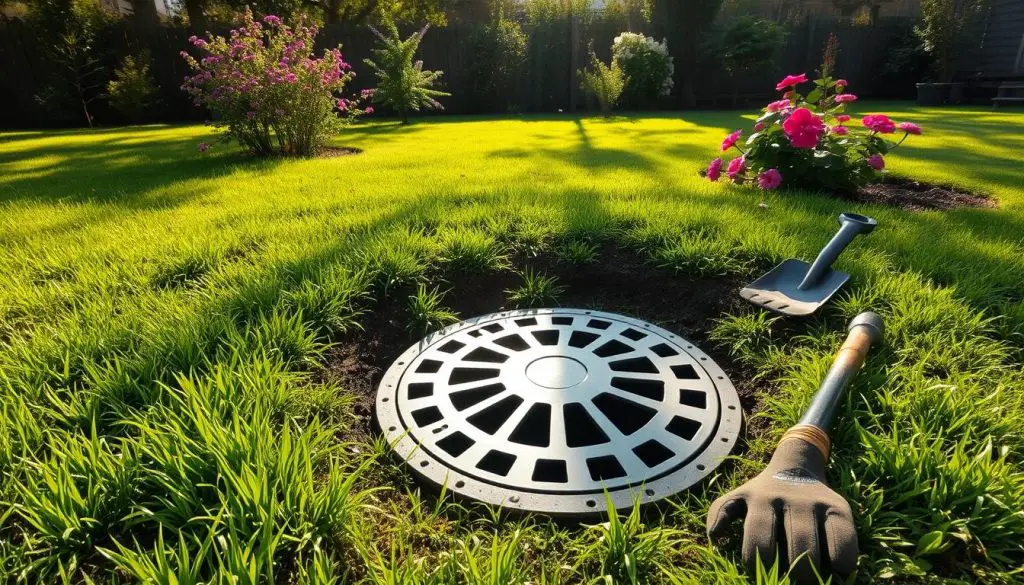Did you know that doing five loads of laundry per day could be the maximum your home’s septic system can handle?
The old one-load-per-day laundry routine is hard to keep up with. It often leads to a big pile of dirty clothes, needing a full “laundry day” to clean up.
We recommend setting aside a specific time, maybe once or twice a week, for laundry. Try to finish at least three loads in one go. You can adjust this based on your schedule and family’s needs. For a family of four, doing two to three of these laundry days a week can keep things in order.
Table of Contents

Daily Laundry Loads and Septic System Impact
Keeping your septic system healthy is key. How often you do laundry can really affect it. A typical septic tank holds about 1,000 gallons of water. It can handle around 500 gallons a day.
But, each load of laundry can add up to 53 gallons. This can quickly overwhelm your system.
Effects on Septic Tank Performance
Doing too many laundry loads in a day can put a lot of pressure on your septic tank. This might cause it to overflow. This can lead to expensive repairs and harm the environment.
To keep your septic tank working well, try to do only 2-3 loads a day. Aim for 7 to 10 loads a week. This depends on your household size, septic tank size, and how water-efficient you are.
Water Usage Considerations
Front-loading washing machines use less water. They are better for your septic system and the environment. Also, using a water-saving detergent helps. Avoid using too much bleach or powdered detergent.
Optimal Load Distribution
Your septic system is designed to handle a certain amount of water each day. This includes water from the bathroom and laundry. Doing laundry throughout the week helps keep the system balanced.
Using too much detergent or bleach can upset the balance in your septic tank. This can cause problems.
| Septic System Capacity | Recommended Laundry Loads | Water Efficiency Impact |
|---|---|---|
| 1,000 gallons | 2-3 loads per day, 7-10 loads per week | Front-loading washers use less water, reducing stress on septic tanks |
| Typical daily handling capacity: 500 gallons | Limit laundry to avoid overwhelming the system | Avoid excessive use of powdered detergents and bleach |
Understanding how laundry affects your septic system is important. By following best practices, you can keep your septic system healthy. This also helps save water.

How Many Loads of Laundry Per Day is Recommended
The right number of laundry loads daily varies by family size and lifestyle. For homes with septic systems, it’s wise to do one or two loads a day. Too many loads can cause wastewater problems and harm the septic tank’s health.
For septic systems, choose laundry detergents that are safe and natural. Look for labels like “natural,” “unscented,” “eco-friendly,” “biodegradable,” “free and clear,” or “fragrance free.” Using high-efficiency washers that use less water can also ease the load on your septic system.
Spreading out laundry throughout the week is better than doing it all at once. This approach prevents overloading the septic tank and ensures a balanced laundry schedule. Doing full loads helps use water efficiently in the septic system.
Regularly cleaning your washing machine’s lint traps is crucial to avoid blockages. These blockages can harm your septic system. The number of laundry days varies, with some doing it once or twice a week. A two-person household might wash 3 to 5 loads, while a four-person household could do 8 to 10 loads weekly.
| Household Size | Recommended Laundry Loads per Week |
|---|---|
| 2-person household | 3-5 loads |
| 4-person household | 8-10 loads |
Considering your household size, clothing needs, and water use can help find the best laundry schedule for your family and septic system.
Creating an Efficient Laundry Schedule System
Setting up a good laundry routine saves us time and effort. It keeps our family’s clothes fresh and organized. With a few simple steps, we can make laundry easier and less stressful.
Organizing Laundry by Categories
Sorting clothes into different groups is a smart move. Use labeled baskets or bins for each type, color, or family member. This makes washing, folding, and putting away clothes much easier.
Time Management Strategies
Don’t try to do all laundry at once. Break it into smaller tasks. Spend 15 minutes a day on laundry to keep clothes clean without it feeling like a burden. Using features like Speed Wash can save time on each load.
Family Size Considerations
The size of our family affects our laundry needs. A family of four can have half a bin of dirty clothes daily. Knowing our family’s needs helps us plan laundry better. Getting kids involved in laundry teaches them responsibility and independence.
Essential Laundry Products and Best Practices
Doing laundry can be easy with the right products. Use eco-friendly detergents that are safe for septic systems. These detergents are good for the planet and your clothes and skin.
Also, have stain removal tools like white vinegar and baking soda ready. Vinegar gets rid of odors, and baking soda helps with tough stains. For delicate items, use mesh bags to keep them safe.
- Opt for septic-safe, biodegradable detergents
- Stock up on white vinegar and baking soda for stain removal
- Use mesh bags to protect small laundry items
For drying, try the dryer-iron method to cut down on ironing. Dry clothes until they’re a bit damp, then iron them quickly. For special care items, write washing instructions and attach them to the garment.
Doing laundry daily helps keep your home tidy. By using these laundry supplies and best practices, you’ll enjoy a stress-free, eco-friendly laundry routine.
| Laundry Item | Recommended Washing Frequency |
|---|---|
| Sheets | At least once a week, more often for hot sleepers |
| Down Pillows | Every 3-6 months to remove bacteria and odors |
| Comforters | Up to twice annually |
| Whites | Separately in hot water to keep them bright |
| Towels | Every 3-4 days for best results |
References:
- Acceptable Daily Loads of Laundry | Montgomery Sanitation in VA
- Managing Laundry with a Septic System: Load Limits and Tips
- How Often Can You Do Laundry Without Sacrificing Your Septic? | Wind River Environmental
Related Articles:

